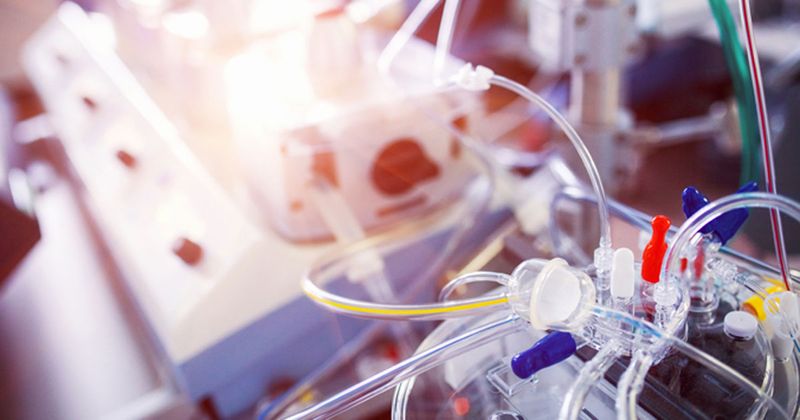Extracorporeal life support does not reduce death risk in acute MI, cardiogenic shock
Key takeaways:
- Using extracorporeal life support early did not reduce death risk at 30 days in patients with MI and cardiogenic shock.
- Bleeding and peripheral complications were higher with early extracorporeal life support.
In patients with acute MI complicated by cardiogenic shock, use of early extracorporeal life support did not reduce risk for death at 30 days compared with medical therapy alone, researchers reported.
Early extracorporeal life support (ECLS), also known as venoarterial extracorporeal membrane oxygenation (VA-ECMO), did not improve 30-day death rates in this population in the ECLS-SHOCK trial or in a meta-analysis of ECLS-SHOCK plus three other trials.

Image: Adobe Stock
The findings were presented at the European Society of Cardiology Congress. ECLS-SHOCK was published in The New England Journal of Medicine. The meta-analysis was published in The Lancet.

About 10% of patients with acute MI have cardiogenic shock, and that group has “mortality of close to 50%,” Holger Thiele, MD, professor of cardiology at Heart Center Leipzig at the University of Leipzig in Germany, said during a press conference. Intra-aortic balloon pumps are no longer recommended by guidelines in favor of “active mechanical circulatory support like a VA-ECMO” or a percutaneous device such as the Impella family of products (Abiomed/Johnson & Johnson), he said, noting that use of both has grown in the past 10 years.
ECLS-SHOCK
For ECLS-SHOCK, Thiele and colleagues randomly assigned 420 patients (median age, 63 years; 81% men) with acute MI and cardiogenic shock to early ECLS plus the usual medical treatment or the usual medical treatment alone.
The primary outcome of all-cause death at 30 days occurred in 47.8% of the ECLS group and 49% of the control group (RR = 0.98; 95% CI, 0.8-1.19; P = .81), Thiele and colleagues found.
“We projected an absolute 14% reduction in all-cause mortality based on previous observational data, and we projected a 49% mortality rate in the control group,” Thiele said. “Interestingly, we reached our projected mortality exactly in the control group. The problem is that we had nearly identical mortality in active group.” He noted there were no benefits from ECLS in any secondary endpoints, including arterial lactate and renal function.
Median duration of mechanical ventilation was 7 days (interquartile range [IQR], 4-12) in the ECLS group and 5 days (IQR, 3-9; median difference, 1 day; 95% CI, 0-2), according to the researchers.
Moderate or severe bleeding occurred in 23.4% of the ECLS group and 9.6% of the control group (RR = 2.44; 95% CI, 1.5-3.95), whereas peripheral vascular complications needing intervention were also more common in the ECLS group (11% vs. 3.8%; RR = 2.86; 95% CI, 1.31-6.25), the researchers found.
“If you ask me, this is a disappointing result,” Thiele said during the press conference. “At least it tells us that what we believe, that if we put in a machine which is providing us with some hemodynamic support, it will reduce mortality” is not accurate.

In a related editorial published in NEJM, Jane A. Leopold, MD, director of the Women’s Interventional Cardiology Health Initiative at Brigham and Women’s Hospital and associate professor of medicine at Harvard Medical School, and Darren B. Taichman, MD, PhD, adjunct professor of medicine at Perelman School of Medicine, University of Pennsylvania, both deputy editors of NEJM, wrote: “If the goal of ECLS is to improve 30-day mortality, these data should steer interventional and critical care cardiologists away from its early routine implementation for all or even most patients with myocardial infarction and cardiogenic shock. There will be some patients in this population for whom ECLS is necessary and lifesaving, but the results of the ECLS-SHOCK trial do not tell us which ones.”
Meta-analysis
The meta-analysis conducted by Thiele and colleagues included four trials including ECLS-SHOCK covering 567 patients (mean age, 64 years; 81% men) assigned to early ECLS plus usual medical therapy or usual medical therapy alone.
There was no difference between the groups in death at 30 days (OR = 0.93; 95% CI, 0.66-1.29), but the ECLS group had higher rates of major bleeding (OR = 2.44; 95% CI, 1.55-3.84) and peripheral ischemic vascular complications (OR = 3.53; 95% CI, 1.7-7.34), according to the researchers.
In prespecified subgroup analyses, there was no indication of benefit for early ECLS (P for interaction .079).
“No subgroups had a benefit” in the trial or the meta-analysis, Thiele said during the press conference. “This leads us to question what we are doing. When we put in large-scale devices that induce bleeding [and] limb ischemia, this may be harmful for the patient. Maybe these also induce inflammation.”
“Rather than routine use of VA-ECMO for infarct-related cardiogenic shock, a more personalized approach could help determine the right strategy for the right patient at the right time,” Prashant Rao, MD, cardiovascular medicine fellow, and Marwa Sabe, MD, assistant professor of medicine, both at Beth Israel Deaconess Medical Center and Harvard Medical School, wrote in a related editorial in The Lancet. “Before embarking on another randomized controlled trial for VA-ECMO, it would be important to identify and enrich for a patient population most likely to benefit from this therapy.”
The ECLS-SHOCK trial and the meta-analysis do not cover the Impella products, Thiele said, noting that they are being evaluated for this population vs. medical therapy in the ongoing DANGER trial.
References:
- Leopold JA, et al. N Engl J Med. 2023;doi:10.1056/NEJMe2309395.
- Rao PR, et al. Lancet. 2023;doi:10.1016/S0140-6736(23)01688-4.
- Thiele H, et al. N Engl J Med. 2023;doi:10.1056/NEJMoa2307227.
- Zeymer U, et al. Lancet. 2023;doi:10.1016/S0140-6736(23)01607-0.


